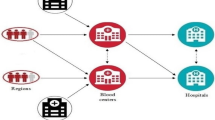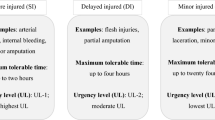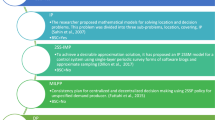Abstract
In natural disasters, having a capable network of collecting and distributing crucial items such as blood is one of the major concerns. However, due to damage to the infrastructure after disasters, mobile blood collecting facilities (blood mobiles) are usually required. This paper aims to decide the locations of mobile facilities in each period for collecting donated blood, plan the blood distribution from the fixed and mobile facilities to the main blood centers, as well as from blood centers to the hospitals and field-hospitals, under uncertain conditions. To do so, a multi-period, bi-objective mixed-integer mathematical model is developed under a multiple-scenario, aiming to minimize the unsatisfied blood demand as well as the total cost of the network. In the proposed model, the blood group compatibility matrix, failure rate of the facilities, and patients’ urgency levels are considered. An augmented ε-constraint method is applied to solve this bi-objective model. Due to the complex nature of the proposed blood supply chain model, the Lagrangian relaxation approach is used to solve the proposed model. An expected Istanbul earthquake is considered, and the blood supply planning through the Red Crescent’s European branch is performed utilizing the proposed model to examine its validity. According to the numerical results, the mobile facilities' locations in each period under each scenario are determined, the unsatisfied demand in each hospital and field-hospital for each blood type are reported, and the tradeoff between the supply chain costs and unsatisfied demand are discussed in detail. Finally, to illustrate the robustness of the proposed model, a detailed sensitivity analysis is performed. According to the study results, opening new blood centers near the high-demand sub-districts for faster testing and supply, increasing the hospitals' capacities, and usage of drones and helicopters for blood distribution are suggested can be considered as managerial insights.

















Similar content being viewed by others
References
Arvan, M., Tavakkoli-Moghaddam, R., & Abdollahi, M. (2015). Designing a bi-objective, multi-product supply chain network for blood supply. Uncertain Supply Chain Management, 3(1), 57–68. https://doi.org/10.5267/j.uscm.2014.8.004.
Bérubé, J.-F., Gendreau, M., & Potvin, J.-Y. (2009). An exact -constraint method for bi-objective combinatorial optimization problems: Application to the traveling salesman problem with profits. European Journal of Operational Research, 194(1), 39–50. https://doi.org/10.1016/j.ejor.2007.12.014.
Cheraghi, S., Hosseini-Motlagh, S.-M., Mohammadreza, G., & Samani, G. (2016). A robust optimization model for blood supply chain network design. International Journal of Industrial Engineering & Production Research, 27(4), 425–444. https://doi.org/10.22068/ijiepr.27.4.425.
Derikvand, H., Hajimolana, S. M., Jabarzadeh, A., & Esmaeel, S. (2019). A fuzzy stochastic bi-objective model for blood provision in disastrous time. Journal of Industrial and Systems Engineering, 12(2), 223–245.
Duan, Q., & Liao, T. W. (2014). Optimization of blood supply chain with shortened shelf lives and ABO compatibility. International Journal of Production Economics, 153, 113–129. https://doi.org/10.1016/j.ijpe.2014.02.012.
Dubey, R., Altay, N., & Blome, C. (2019a). Swift trust and commitment: The missing links for humanitarian supply chain coordination? Annals of Operations Research, 283(1–2), 159–177. https://doi.org/10.1007/s10479-017-2676-z.
Dubey, R., Gunasekaran, A., Bryde, D. J., Dwivedi, Y. K., & Papadopoulos, T. (2020). Blockchain technology for enhancing swift-trust, collaboration and resilience within a humanitarian supply chain setting. International Journal of Production Research, 58(11), 3381–3398. https://doi.org/10.1080/00207543.2020.1722860.
Dubey, R., Gunasekaran, A., Childe, S. J., Roubaud, D., Fosso Wamba, S., Giannakis, M., & Foropon, C. (2019b). Big data analytics and organizational culture as complements to swift trust and collaborative performance in the humanitarian supply chain. International Journal of Production Economics, 210, 120–136. https://doi.org/10.1016/j.ijpe.2019.01.023.
Dubey, R., Gunasekaran, A., & Papadopoulos, T. (2019). Disaster relief operations: past, present and future. Annals of Operations Research. https://doi.org/10.1007/s10479-019-03440-7.
Eskandari-Khanghahi, M., Tavakkoli-Moghaddam, R., Taleizadeh, A. A., & Amin, S. H. (2018). Designing and optimizing a sustainable supply chain network for a blood platelet bank under uncertainty. Engineering Applications of Artificial Intelligence, 71, 236–250. https://doi.org/10.1016/j.engappai.2018.03.004.
Fahimnia, B., Jabbarzadeh, A., Ghavamifar, A., & Bell, M. (2017). Supply chain design for efficient and effective blood supply in disasters. International Journal of Production Economics, 183, 700–709. https://doi.org/10.1016/j.ijpe.2015.11.007.
Fazli-Khalaf, M., Khalilpourazari, S., & Mohammadi, M. (2019). Mixed robust possibilistic flexible chance constraint optimization model for emergency blood supply chain network design. Annals of Operations Research, 283(1–2), 1079–1109. https://doi.org/10.1007/s10479-017-2729-3.
Fereiduni, M., & Shahanaghi, K. (2016). A robust optimization model for blood supply chain in emergency situations. International Journal of Industrial Engineering Computations, 7(4), 535–554. https://doi.org/10.5267/j.ijiec.2016.5.002.
Ghatreh Samani, M. R., Torabi, S. A., & Hosseini-Motlagh, S. M. (2018). Integrated blood supply chain planning for disaster relief. International Journal of Disaster Risk Reduction, 27, 168–188. https://doi.org/10.1016/j.ijdrr.2017.10.005.
Gordon, G. J., Varakantham, P., Yeoh, W., Lau, H. C., Aravamudhan, A. S., & Cheng, S.-F. (2012). Lagrangian relaxation for large-scale multi-agent planning. In 2012 IEEE/WIC/ACM international conferences on web intelligence and intelligent agent technology (pp. 494–501). IEEE. https://doi.org/10.1109/WI-IAT.2012.252.
Gunasekaran, A., Dubey, R., Wamba, S. F., Papadopoulos, T., Hazen, B. T., & Ngai, E. W. T. (2018). Bridging humanitarian operations management and organisational theory. International Journal of Production Research, 56(21), 6735–6740. https://doi.org/10.1080/00207543.2018.1551958.
Gunpinar, S., & Centeno, G. (2016). An integer programming approach to the bloodmobile routing problem. Transportation Research Part E: Logistics and Transportation Review, 86, 94–115. https://doi.org/10.1016/j.tre.2015.12.005.
Habibi-Kouchaksaraei, M., Paydar, M. M., & Asadi-Gangraj, E. (2018). Designing a bi-objective multi-echelon robust blood supply chain in a disaster. Applied Mathematical Modelling, 55, 583–599. https://doi.org/10.1016/j.apm.2017.11.004.
Haimes, Y., Ladson, L., & Wismer, D. (1971). On a bicriterion formulation of the problems of integrated system identification and system optimization. IEEE Transactions on Systems, Man, and Cybernetics, 1(3), 296–297. https://doi.org/10.1109/TSMC.1971.4308298.
Hamdan, B., & Diabat, A. (2019). A two-stage multi-echelon stochastic blood supply chain problem. Computers and Operations Research, 101, 130–143. https://doi.org/10.1016/j.cor.2018.09.001.
Hamdan, B., & Diabat, A. (2020). Robust design of blood supply chains under risk of disruptions using Lagrangian relaxation. Transportation Research Part E: Logistics and Transportation Review, 134, 101764. https://doi.org/10.1016/j.tre.2019.08.005.
Heidari-Fathian, H., & Pasandideh, S. H. R. (2018). Green-blood supply chain network design: Robust optimization, bounded objective function & Lagrangian relaxation. Computers and Industrial Engineering, 122, 95–105. https://doi.org/10.1016/j.cie.2018.05.051.
Hogan, D. E., & Burstein, J. L. (2007). Disaster medicine. Philadelphia: Lippincott Williams & Wilkins.
Hosseinifard, Z., & Abbasi, B. (2018). The inventory centralization impacts on sustainability of the blood supply chain. Computers and Operations Research, 89, 206–212. https://doi.org/10.1016/j.cor.2016.08.014.
Imai, A., Nishimura, E., & Current, J. (2007). A Lagrangian relaxation-based heuristic for the vehicle routing with full container load. European Journal of Operational Research, 176(1), 87–105. https://doi.org/10.1016/j.ejor.2005.06.044.
Jabbarzadeh, A., Fahimnia, B., & Seuring, S. (2014). Dynamic supply chain network design for the supply of blood in disasters: A robust model with real world application. Transportation Research Part E: Logistics and Transportation Review, 70(1), 225–244. https://doi.org/10.1016/j.tre.2014.06.003.
Kamali, B., Bish, D., & Glick, R. (2017). Optimal service order for mass-casualty incident response. European Journal of Operational Research, 261(1), 355–367. https://doi.org/10.1016/j.ejor.2017.01.047.
Khalilpourazari, S., & Arshadi Khamseh A. (2019). Bi-objective emergency blood supply chain network design in earthquake considering earthquake magnitude: A comprehensive study with real world application. Annals of Operations Research, 283(1), 355–393. https://doi.org/10.1007/s10479-017-2588-y.
Khalilpourazari, S., Soltanzadeh, S., Weber, G. W., & Roy, S. K. (2019). Designing an efficient blood supply chain network in crisis: Neural learning, optimization and case study. Annals of Operations Research. https://doi.org/10.1007/s10479-019-03437-2.
Kohneh, J. N., Teymoury, E., & Pishvaee, M. S. (2016). Blood products supply chain design considering disaster circumstances (Case study: Earthquake disaster in Tehran). Journal of Industrial and Systems Engineering, 9, 51–72.
Ma, Z. J., Wang, K. M., & Dai, Y. (2019). An emergency blood allocation approach considering blood group compatibility in disaster relief operations. International Journal of Disaster Risk Science, 10(1), 74–88. https://doi.org/10.1007/s13753-018-0212-7.
Marler, R. T., & Arora, J. S. (2004). Survey of multi-objective optimization methods for engineering. Structural and Multidisciplinary Optimization, 26(6), 369–395. https://doi.org/10.1007/s00158-003-0368-6.
Mavrotas, G. (2009). Effective implementation of the ε-constraint method in multi-objective mathematical programming problems. Applied Mathematics and Computation, 213(2), 455–465. https://doi.org/10.1016/j.amc.2009.03.037.
Miettinen, K. (2008). Introduction to multiobjective optimization: Noninteractive approaches (pp. 1–26). https://doi.org/10.1007/978-3-540-88908-3_1.
Mills, A. F., Argon, N. T., & Ziya, S. (2013). Resource-based patient prioritization in mass-casualty incidents. Manufacturing and Service Operations Management, 15(3), 361–377. https://doi.org/10.1287/msom.1120.0426.
Modgil, S., Singh, R. K., & Foropon, C. (2020). Quality management in humanitarian operations and disaster relief management: A review and future research directions. Annals of Operations Research. https://doi.org/10.1007/s10479-020-03695-5.
Mukaka, M. M. (2012). Statistics corner: A guide to appropriate use of correlation coefficient in medical research. Malawi Med. J., 24(3), 69–71.
Nagurney, A., Masoumi, A. H., & Yu, M. (2012). Supply chain network operations management of a blood banking system with cost and risk minimization. Computational Management Science, 9(2), 205–231. https://doi.org/10.1007/s10287-011-0133-z.
Oksuz, M. K., & Satoglu, S. I. (2020). A two-stage stochastic model for location planning of temporary medical centers for disaster response. International Journal of Disaster Risk Reduction, 44, 101426. https://doi.org/10.1016/j.ijdrr.2019.101426.
Osiadacz, A. J. (1989). Multiple criteria optimization; theory, computation, and application, Ralph E. Steuer, Wiley series in probability and mathematical statistics—Applied, Wiley, 1986, No. of pages 546, Price f5 1.40, $77.10. Optimal Control Applications and Methods, 10(1), 89–90. https://doi.org/10.1002/oca.4660100109.
Osorio, A. F., Brailsford, S. C., Smith, H. K., Forero-Matiz, S. P., & Camacho-Rodríguez, B. A. (2017). Simulation-optimization model for production planning in the blood supply chain. Health Care Management Science, 20(4), 548–564. https://doi.org/10.1007/s10729-016-9370-6.
Rahmani, D. (2019). Designing a robust and dynamic network for the emergency blood supply chain with the risk of disruptions. Annals of Operations Research, 283(1–2), 613–641. https://doi.org/10.1007/s10479-018-2960-6.
Ramezanian, R., & Behboodi, Z. (2017). Blood supply chain network design under uncertainties in supply and demand considering social aspects. Transportation Research Part E: Logistics and Transportation Review, 104, 69–82. https://doi.org/10.1016/j.tre.2017.06.004.
Repoussis, P. P., Paraskevopoulos, D. C., Vazacopoulos, A., & Hupert, N. (2016). Optimizing emergency preparedness and resource utilization in mass-casualty incidents. European Journal of Operational Research, 255(2), 531–544. https://doi.org/10.1016/j.ejor.2016.05.047.
Salehi, F., Mahootchi, M., & Husseini, S. M. M. (2019). Developing a robust stochastic model for designing a blood supply chain network in a crisis: A possible earthquake in Tehran. Annals of Operations Research, 283(1–2), 679–703. https://doi.org/10.1007/s10479-017-2533-0.
Salman, F. S., & Gül, S. (2014). Deployment of field hospitals in mass casualty incidents. Computers and Industrial Engineering, 74(1), 37–51. https://doi.org/10.1016/j.cie.2014.04.020.
Samani, M. R. G., & Hosseini-Motlagh, S. M. (2019). An enhanced procedure for managing blood supply chain under disruptions and uncertainties. Annals of Operations Research, 283(1–2), 1413–1462. https://doi.org/10.1007/s10479-018-2873-4.
Schiffling, S., Hannibal, C., Tickle, M., & Fan, Y. (2020). The implications of complexity for humanitarian logistics: A complex adaptive systems perspective. Annals of Operations Research. https://doi.org/10.1007/s10479-020-03658-w.
Sha, Y., & Huang, J. (2012). The multi-period location-allocation problem of engineering emergency blood supply systems. Systems Engineering Procedia, 5, 21–28. https://doi.org/10.1016/j.sepro.2012.04.004.
Ülkü, M. A., Bell, K. M., & Wilson, S. G. (2015). Modeling the impact of donor behavior on humanitarian aid operations. Annals of Operations Research, 230(1), 153–168. https://doi.org/10.1007/s10479-014-1623-5.
Zahiri, B., & Pishvaee, M. S. (2017). Blood supply chain network design considering blood group compatibility under uncertainty. International Journal of Production Research, 55(7), 2013–2033. https://doi.org/10.1080/00207543.2016.1262563.
Funding
No funding was received for this study.
Author information
Authors and Affiliations
Corresponding author
Ethics declarations
Conflict of interest
The authors declare that they have no conflict of interest.
Additional information
Publisher's Note
Springer Nature remains neutral with regard to jurisdictional claims in published maps and institutional affiliations.
Rights and permissions
About this article
Cite this article
Farrokhizadeh, E., Seyfi-Shishavan, S.A. & Satoglu, S.I. Blood supply planning during natural disasters under uncertainty: a novel bi-objective model and an application for red crescent. Ann Oper Res 319, 73–113 (2022). https://doi.org/10.1007/s10479-021-03978-5
Accepted:
Published:
Issue Date:
DOI: https://doi.org/10.1007/s10479-021-03978-5




